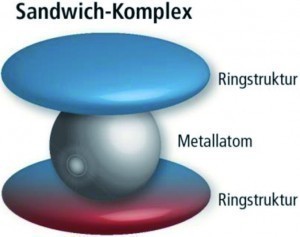Rare earths are a component of many high-tech products due to their special properties. Scientists at the Karlsruhe Institute of Technology (KIT) are working on new ways of using these elements. The team is producing so-called sandwich complexes with rare earths, which could serve as new molecular materials for more powerful storage media or displays in the future. The German Research Foundation (DFG) is funding the pioneering study with 500,000 euros as a Reinhart Koselleck project.
Sandwich complexes are chemical molecules whose properties are still largely unknown. The compounds consist of two ring structures between which a single metal atom is "sandwiched". In simple terms, the complexes look like tiny sandwiches. In order to investigate whether the molecules are suitable as an innovative basis for future materials, Professor Peter Roesky, Head of the Chair of Inorganic Functional Materials at the Institute of Inorganic Chemistry (AOC) and his team are producing different variants of the sandwich complexes in the laboratory. The scientists use various elements from the rare earth group as metal atoms in the middle of the compounds. The experimental molecules also differ in terms of their ring structures. In addition to carbon, the rings consist of a variable proportion of other elements. The researchers are experimenting with different ring sizes. The project aims to systematically vary the size and composition of the rings in order to establish a structure-activity principle. "We are investigating what influence the structure of the sandwich complexes has on their physical properties," explains Roesky. "In particular, we are investigating the magnetism and luminescence of the molecules."
 Schematic representation of a sandwich complex with a lower ring composed of various elementsSo far,rare earths have generally been integrated into solid-state materials that are used in high-tech products. The elements can be found in LED lights, cell phone displays and wind turbine magnets, for example. With the production of his planned molecular compounds with rare earths, Roesky is pursuing an approach that has hardly been considered in applications to date.
Schematic representation of a sandwich complex with a lower ring composed of various elementsSo far,rare earths have generally been integrated into solid-state materials that are used in high-tech products. The elements can be found in LED lights, cell phone displays and wind turbine magnets, for example. With the production of his planned molecular compounds with rare earths, Roesky is pursuing an approach that has hardly been considered in applications to date.
Ideally, the scientists could, among other things, obtain molecules that behave like tiny magnets. Such compounds are also known as single-molecule magnets. One day, the novel complexes could be used to produce storage media that have greatly increased storage capacities with the same physical size. Roesky and his team are also experimenting with rare earth elements, which are already used in phosphors. Sandwich complexes containing these elements could later be used to produce optimized displays, for example. "Our project serves to create a basic understanding of these novel substances," explains Roesky.
As the scientists are at the very beginning of a new field of research with their project, success is not guaranteed. Through Reinhart Koselleck Projects, the DFG specifically funds such high-risk projects and thus gives established researchers the opportunity to implement innovative ideas. Across all disciplines, only eight of them were funded by a Reinhart Koselleck project in Germany in 2019. Roesky is the first KIT scientist to receive this financial support. The funds, which are designed for five years, can be used freely.


